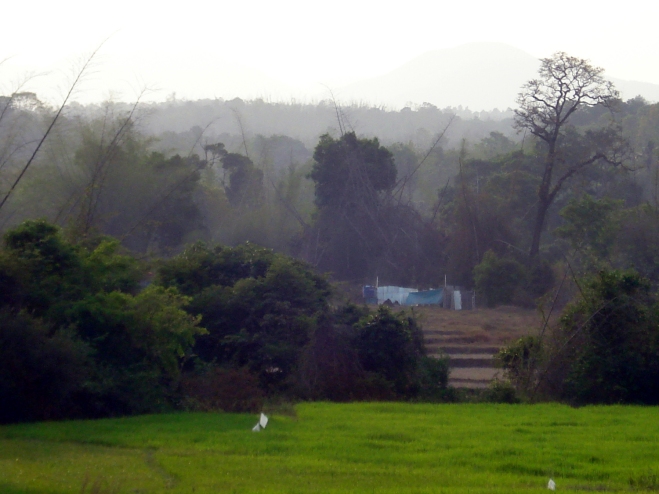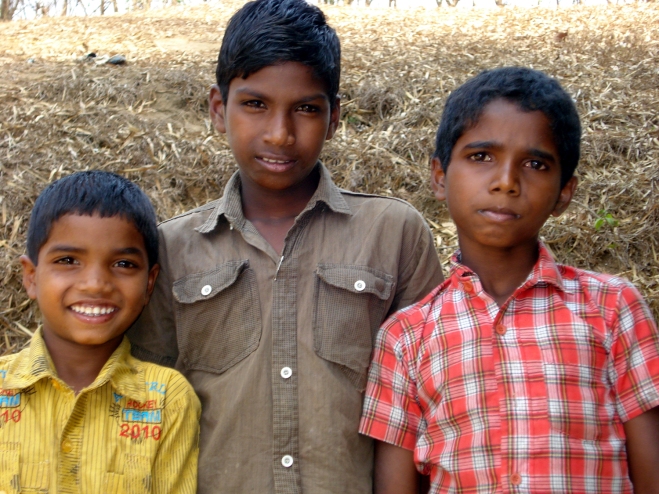We waded our way across the river Kabani and followed the path adjacent to the reserve forest. Our tribal guide warns we are vulnerable to an attack by herds of wild elephants at any point of time. We are heading to a tribal village. My guests Stephanie and Tanya from Switzerland looks excited about this visit. We are in the vicinity of the village. A group of tribal me walk past us and they turn their head in slight annoyance. Perhaps they might be tired of visitors flocking to their dwellings nowadays. We are part of a tribal village visit that is currently rampant in Wayanad.
We enter the village and the tribal kids sighting us darted across the narrow path and leap to the river to avoid our presence. They remained in the neck deep waters till our exit. Women withdrew to the interior of their houses and the most of the males were reluctant to speak. Our tribal guide was forcing them to come out and interact with us, but his effort was in vain. An elderly woman who looked friendly smiled at us and was ready to talk to us and posed for some snaps. But as a whole the tribal’s looked offended and were very withdrawn. Stephanie seems to be a bit irritated and said this was a refined form of Human Safari. She says this harassment of the natives should be barred.
“Human safari” is an organized tour that takes visitors to a place where they can observe “locals” or “natives” in their aboriginal settings. Some say this is cultural tourism. True cultural tourism offers an opportunity for interaction, shopping opportunities, food ways demonstrations or craft lessons. A tour that takes tourists to a tribal village, encourages tourists to bribe locals with food or money to perform a dance and permits the tourists to film the entire experience would definitely fall into the “human safari” category.
The tribal village visitors also continuously shoot close up “candid” photos of the tribal people. They have little or no cultural interest in the adivasi other than a few hundred digital photos that will remain dormant on their computer’s hard drive till it is removed permanently. They also might force their half interested friends to see these photos.
The tribal villages in wayanad are becoming showcases for visiting tourists, with little benefits shared with the communities themselves. Cultural dances and artefacts become little more than commodities for tourists, often bought very cheaply and sold by middlemen. In the future all of this can lead to feelings of frustration and resentment amongst tribal people towards tourists. The positive experience that should come with equitable cultural exchange might never surface.
Current tourism practices only add to the already long list of people taking advantage of these mostly uneducated and shy people. The local benefit is a few rupees and couple of packets of biscuits spread around a handful of villages and the empty promises to send some photos once the tourists are back home. No wonder some of these people have started showing resentment against the offending tourists these days.
The tour guides, tour operators and some accommodation providers argue this benefits the local handicrafts and cottage industries. The fact is the local handicraft industry has almost been destroyed by these same tourist lobbies, who, behind the scenes are garnisheeing up hefty commission marketing the handicrafts and souvenirs that is flooding Wayanad from other parts of India. What chance do these little village handicrafts and forest-crafts have when they are strangled right at inception by insatiable greed?
Do the tribal people themselves want these village visit by tourists or is it being inflicted upon them without consultation?
However the government has no interest in saving the tribal’s from harassment. Tribal’s are harassed, threatened and exploited in so many places, by so many people, groups, businessmen or institutions. Nobody cares because the number of tourists and the number of tribal villages they are going to must be rather small.





There are so few primitive tribes left. Most have been over-run by what we like to call ‘civilization’. That wonderful way of life, self-contained, adequate to all needs, is hard to find. Oh that I were Margaret Meade in her day, when she went alone, lived with them, observed, became them.
🙂